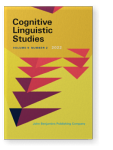Vol. 9:2 (2022) ► pp.401–428
An aspectual account of constructions headed by unergatives and unaccusatives
This article presents an aspectual account of the interface between lexicon and syntax. Following Tenny’s AIH (Aspectual Interface Hypothesis), we assume that only the aspectual property of lexical information is sensitive and predictive to argument structure. Based on this assumption, the article claims that aspectual roles associated with measuring-out and delimitedness offer a single and unified account of argument structure. To begin with, a peculiar focus is given to the direct internal argument which serves as the only measuring-out role and participates the measurement constraint in three verb types including the incremental-theme verbs, the change-of-state verbs and route verbs with path objects, Another aspectual property is delimitedenss that functions as the terminus role of event progression in the form of delimiting markers such as verb particles or resultative predicates.To better testify the claim, the article focuses on constructional variations derived from some typical unergatives and unaccusatives, because the semantic distinction between the two verb types is mainly reflected on the syntactic property that urergatives normally require an agent while unaccusatives ask for a compulsory theme or patient. Yet Constructional variations derived from unergatives and unaccusatives consistently instantiate the measuring-out constraint on direct internal argument. For unergatives, an undelimited event is converted into a delimited one by addition of measuring direct argument, while for unaccusatives, semantic differences arise from alternating arguments that go through changes. Hence constructional variations further prove that syntactic structure fundamentally operates over the aspectual roles rather than thematic roles.
Article outline
- 1.Introduction
- 2.Theoretical background
- 2.1Aspectual roles and thematic roles
- i.The measure aspectual role
- ii.The terminus aspectual role
- iii.The path aspectual role
- 2.2Aspectual structure and argument structure
- 2.3Delimitedness and its specification
- 2.4Event delimiting image and delimiting markers
- 2.1Aspectual roles and thematic roles
- 3.Syntactic and semantic attributes of unergatives and unaccusatives
- 3.1Constructions derived from unergatives
- 3.1.1The cognate object construction
- 3.1.2The his/her way construction
- 3.1.3Reflexive object construction
- 3.1.4Expletive body parts construction
- 3.2Constructions derived from unaccusatives
- 3.2.1Syntactic contrast between agents and themes/patients
- 3.2.2Location/theme alternation construction
- 3.2.3 There-be construction
- 3.2.4Unaccuative verb die in cognate object construction
- 3.1Constructions derived from unergatives
- 4.Conclusion
- Notes
-
References
